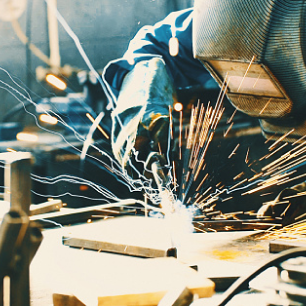Jump to:
Rope Access for Nondestructive Examination
Rope access is a flexible form of work positioning that allows workers to access remote and hard-to-reach locations — such as offshore platforms, high-rise buildings, and bridges — safely and efficiently without cradles, scaffolding, or platforms. Using ropes and specialized equipment, the technique makes ascending, descending, and navigating across structures possible. The rope-access system secures workers, allowing them to work at height or in confined spaces, often with reduced risk compared to other methods of working at height.
Generally, a two-rope system is employed: the working rope supports the worker, and the safety rope provides back-up fall protection. Rope access benefits include increased safety for the worker and cost savings for the client.
Rope Access Certification for the Welding Inspector
Qualifications for inspection personnel are gained over a period of years, and it makes sense to invest in additional qualifications to enhance their value. Rope access certification, particularly Industrial Rope Access Trade Association (IRATA International) certification, is an international qualification that includes a rigorous testing process, similar to inspection qualification. Admittedly, rope access is not for everyone. It requires patience, attention to detail, interest in technical systems and equipment, and a certain level of physical fitness. If it’s a good fit for the right individual, rope access can significantly increase the scope and range of application for a welding inspector’s skillset and bring greater value to employers and customers. Many major asset management companies have rope-access programs and recognize the value that they can offer clients.
Why Use Rope Access
Modern rope-access equipment, techniques, and training can be combined to produce a safe, versatile, efficient, and cost-effective way to solve vertical access problems. Some of its benefits are as follows:
Safety: Independently certified rope-access technicians uphold an enviable safety record and few lost time incidents while working on rope.
Versatility: Technicians can apply the techniques in various environments, from confined-space penstocks to massive concrete structures to complicated steel installations. Unlike traditional access methods, custom rope-access solutions can be designed to fit multiple applications quickly and inexpensively.
Efficiency: Systems are installed and dismantled quickly and often require fewer personnel than traditional access methods. Rapid deployment minimizes downtime and limits disruption to facility operations. Reduced hours at risk are a considerable advantage over other access methods.
Cost: Fewer personnel, faster completion, less equipment, and minimal downtime mean lower costs.
Rope access can be used for structural inspections, repairs, coating application and stripping, re-installation of insulation, and welding inspection. Production facilities with vessels that need regular inspections often fail to include adequate catwalk access and can be too congested for mobile platforms. Specific structures like bridges, dams, roofs, and amusement park rides do not lend themselves to scaffolding or other traditional methods. If the facility is located offshore, space is at a premium. Rope access is often preferred because it requires less manpower and equipment.
Although rope access is a good fit with most inspection work, it is not a good fit or necessary for all. For example, new construction and major renovations usually include scaffolding structures, which would provide access solutions for all trades, including inspectors.
Rope-Access Implementation
There are several ways to get started with rope access, such as subcontracting, acquisition or partnership, and program development, but it can also take a blended approach.
SUBCONTRACTING: The benefits of this method include the fact that the company has specialist expertise in rope-access methodology, and it can be a cost- and time-effective option if rope access is a small portion of the overall business. This method allows the relationship to grow and evolve with your needs. For example, the subcontractor could provide training, IRATA Level 3 supervision, key personnel, or turnkey service. Another significant advantage is talent recruitment — becoming certified takes a week, but new IRATA Level 1 technicians require much more supervision and become more productive and efficient with experience. The disadvantages are that there’s no direct control over the program, employees, or equipment, and it can be expensive if rope access represents a high volume of business.
ACQUISITION OR PARTNERSHIP: The company acquires specialist expertise in rope-access methodology and assumes direct control over the program. This method can jumpstart the program regarding personnel, equipment, and client relationships and strategically combine other goals, such as movement into other markets, regions, and services. However, this method is a significant investment and takes time and resources. Furthermore, finding the right fit can be challenging.
PROGRAM DEVELOPMENT: This method includes oversight (management and supervision), technician competency (training program), and equipment management. A rope-access program is like any other program in which organization, leadership, teamwork, and communication are essential.
Regulations and Standards
Rope access is governed by strict safety protocols and guidelines to ensure the safety of the operators. Four organizations mainly regulate the method: the Occupational Safety and Health Administration (OSHA), the American National Standards Institute (ANSI), the Society of Professional Rope Access Technicians (SPRAT), and IRATA International. OSHA is a required regulation, while the others are voluntary.
General OSHA requirements apply to rope access, including personal protection equipment (PPE), training, emergency preparedness, and providing a safe workplace. However, OSHA does not attempt to provide specific guidance for rope access methods within their current standards.
ANSI has recently released a standard for rope access. However, this standard is not widely used or accepted.
IRATA Requirements and Guidance
IRATA International provides robust guidelines for a safe work system and encourages career progression for rope access technicians. Each technician must recertify every three years to demonstrate that they maintain the necessary abilities to work safely. Technicians may also progress through three levels as time, experience, and training allow, each demanding a greater knowledge of the rope access skills necessary at the worksite.
IRATA requirements for company membership are as follows:
- Must be an incorporated entity (registered company),
- Documented rope-access operating and training procedures,
- Employment of an IRATA Level 3 technician as the technical authority,
- Compliance with Intelligence Carry On Program (ICOP) for operations and training,
- Abide by IRATA bylaws and articles of association,
- All employees must be IRATA certified (first aid and cardiopulmonary resuscitation [CPR] for Level 3s),
- Employ a rope-access manager, and
- Be subject to audit in accordance with the membership audit cycle.
IRATA Certification Requirements. The IRATA training scheme includes class-based learning, theoretical and practical testing, and field experience. The goal is competent technicians who support a safe, quality program. An audited training member company must deliver training.
The levels of qualification within the IRATA system are as follows:
- Level 1. A rope-access technician who is able to perform a specified range of rope-access tasks under the supervision of a Level 3 Rope Access Safety Supervisor.
- Level 2. An experienced rope-access technician who is able to perform more complex tasks under the supervision of a Level 3 Rope Access Safety Supervisor.
- Level 3. An experienced rope-access technician who is responsible for understanding and implementing the rope-access procedures, method statements, and associated risk assessments as well as,
a) is able to demonstrate the skills and knowledge required of Levels 1 and 2,
b) understands the elements and principles of IRATA’s safe system of work,
c) is conversant with relevant work techniques and legislation,
d) has an extensive knowledge of advanced rope access rigging and rescue techniques, and
e) holds an appropriate and current first aid certificate.
A Level 3 can become a Rope Access Safety Supervisor.
SPRAT Requirements and Guidance
In contrast to IRATA, SPRAT has few requirements for member companies. SPRAT specifications are as follows:
- Required to hold a company membership,
- Minimal program requirements and no audits,
- Program oversight by a rope-access program, administrator with minimal qualifications needed, and
- Technicians must hold rope-access certification, and it is recommended that this certification meets the SPRAT scheme.
SPRAT certification requirements are as follows:
- Training is required for initial certification,
- Training is recommended for recertification,
- Supervisory requirements include a recommendation for Level 3, and
- Upgrade requirements are 500 hours and six months.
Final Thoughts
Rope-access program and certification considerations include geographical location and client requirements. If a client requires IRATA, then SPRAT will not meet that standard because IRATA requirements are more stringent and enforced by audit. Likewise, IRATA member companies can only employ IRATA-certified technicians.
IRATA is the largest rope-access organization worldwide and is recommended for international projects and clients with global assets. IRATA provides more rigorous certifications, detailed standards, and an audited membership.
SPRAT is the largest rope-access organization based in the United States. It is more flexible, has less stringent standards, and does not require audits.
Similar to an inspection program, a rope-access program needs a strong foundation based on rigorous standards. Both IRATA and SPRAT promote rope-access standards and safety, and more information is available on their respective websites, irata.org and sprat.org.
Robert Goodwin (bob@rigintlgrp.com) manages rope access standards at Rigging International Group, Las Vegas, Nev. He began rigging and working at height in 2001 and has held an IRATA Level 3 certification since 2009. He is also an IRATA international assessor, instructor, and SPRAT evaluator. Chad Umbel (chad@rigintlgrp.com) manages field rope access and construction operations at Rigging International Group, Las Vegas, Nev. He oversees heavy construction and demolition projects in the oil and gas industry, including ice wraps and ice breakers in Cook Inlet, Alaska.


